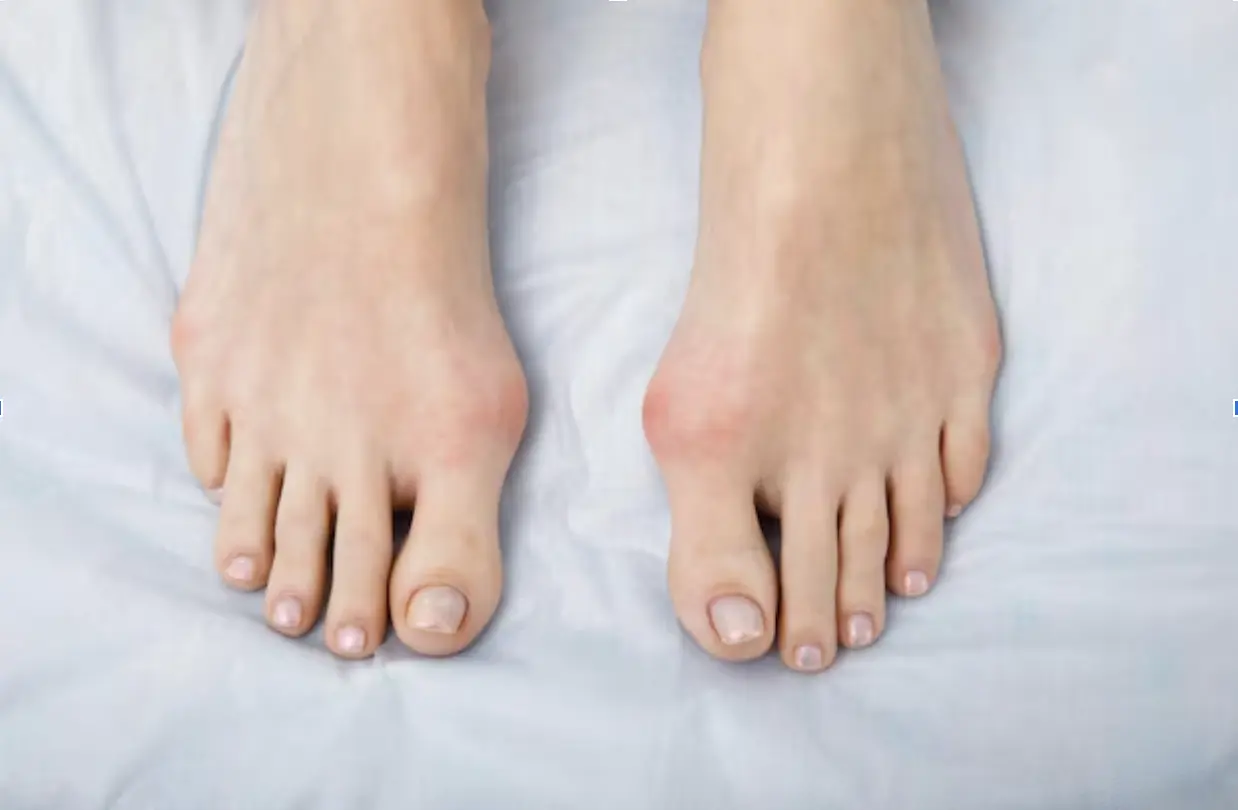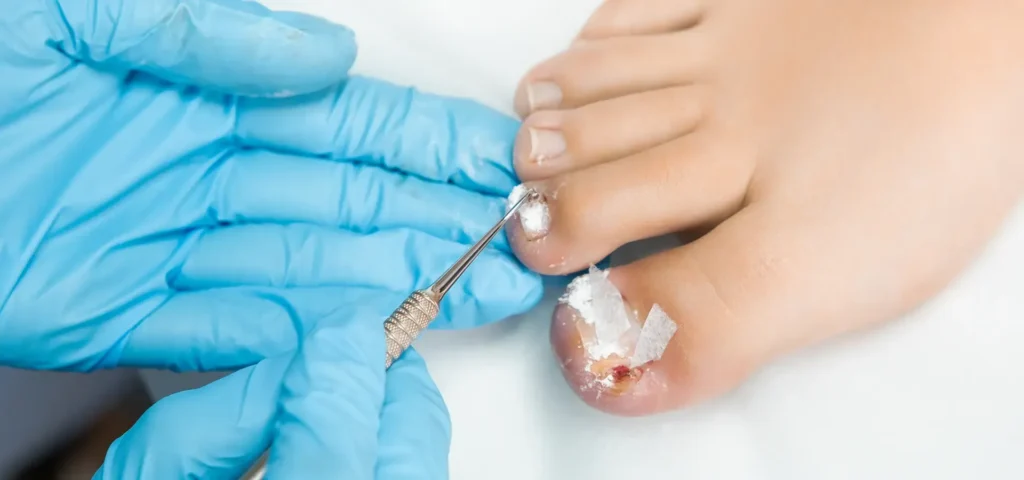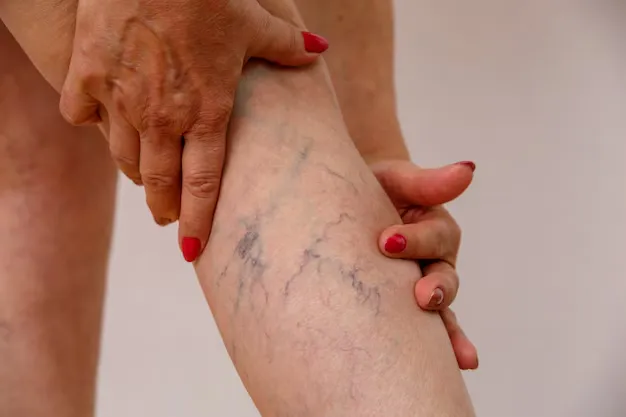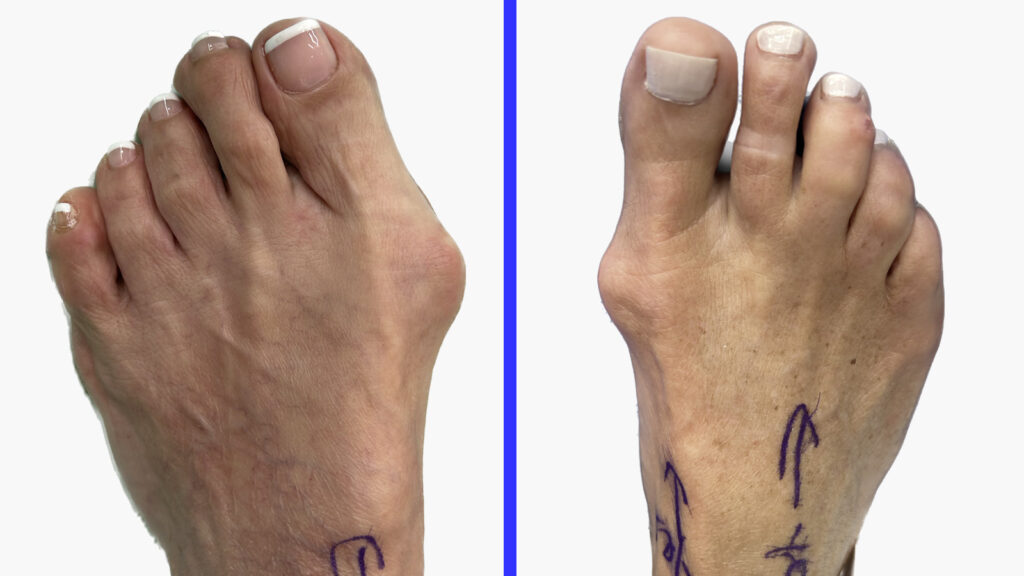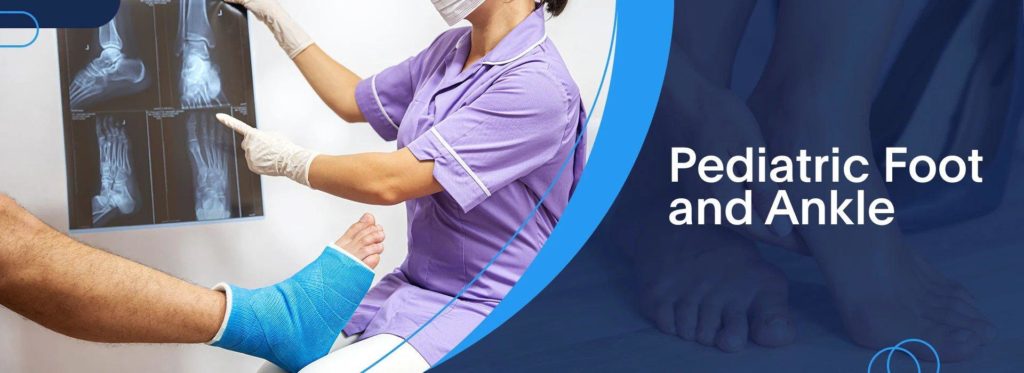You’ve noticed a bump forming along the side of your big toe. Maybe it’s starting to rub against your shoes or ache after a long day on your feet.
Is it something to be concerned about, or just a harmless quirk of your foot shape?
Bunions are one of the most common foot problems we see at Foot, Ankle & Leg Vein Center.
Yet many people don’t recognize the early signs until the condition starts interfering with their daily lives.
Left unaddressed, bunions can lead to persistent pain, difficulty walking, and even joint damage.
In this article, we’ll show you exactly what a bunion looks like, how to recognize the most common symptoms, and when it’s time to consider professional care.
Whether you’re simply curious or worried about changes in your foot, this guide will give you clear, practical answers.
What Is a Bunion?
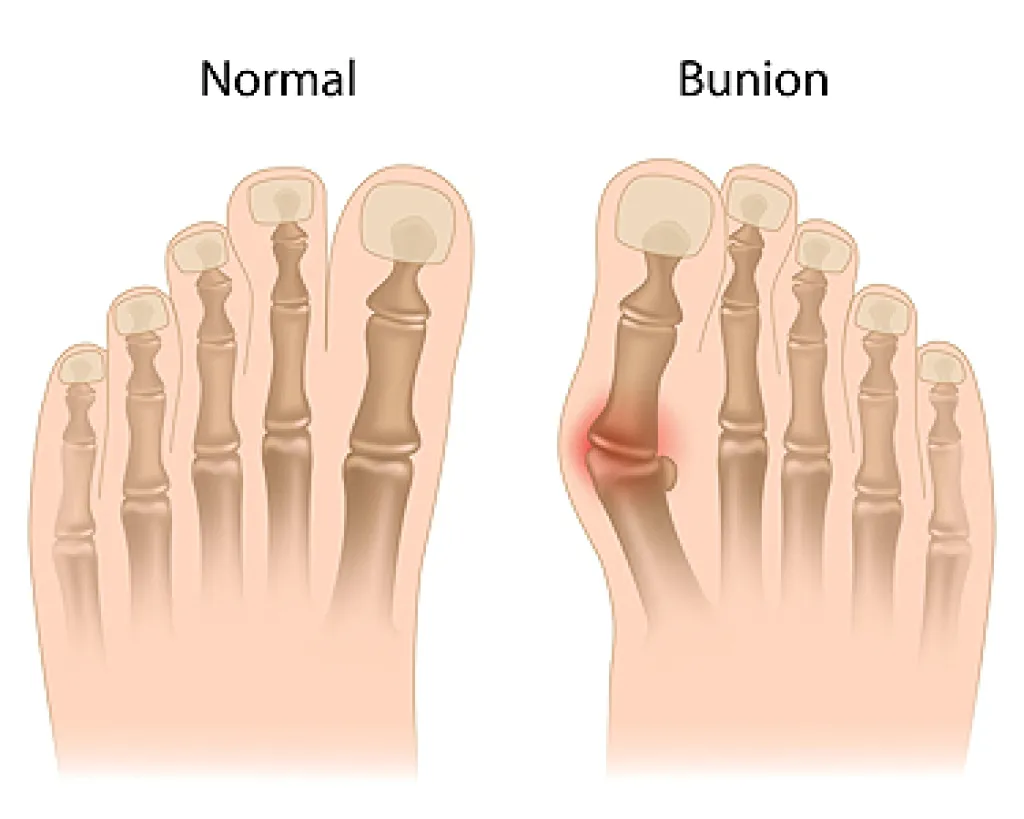
A bunion is a bony bump that forms on the joint at the base of your big toe. But it’s more than just a bump, it’s a sign that the bones in the front part of your foot are shifting out of place.
As this happens, the big toe leans toward the second toe, gradually pushing the joint outward and creating that characteristic bulge.
Bunions can start small and painless, but over time, they often become swollen, red, and sore, especially when aggravated by tight or narrow shoes.
The condition is progressive, meaning it tends to worsen without proper management.
While genetics plays a significant role in bunion development, other factors like footwear, foot injuries, and certain medical conditions can also contribute.
What Causes Bunions?
Bunions develop due to a combination of genetic and environmental factors:
- Genetics: Inherited foot structures, such as flat feet or loose ligaments, predispose individuals to bunions.
- Footwear: High heels and narrow-toed shoes increase pressure on the forefoot, accelerating bunion formation.
- Medical conditions: Arthritis, particularly rheumatoid arthritis, can contribute to joint instability.
- Injuries: Trauma or stress fractures in the foot can alter biomechanics, leading to bunions over time.
Understanding these causes helps in both prevention and treatment planning.
What Does a Bunion Look Like?
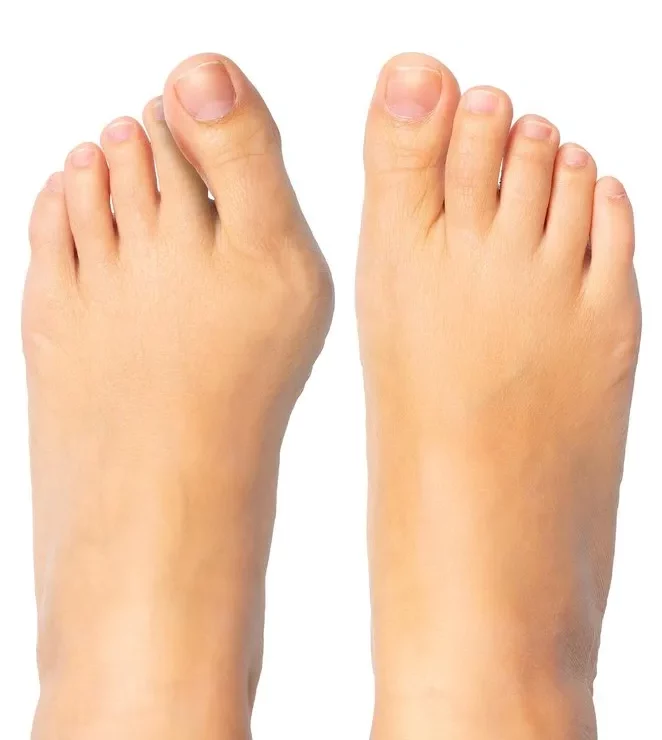
A bunion typically appears as a noticeable bump on the inner edge of the foot, right at the base of the big toe.
But it’s not just the bump you need to look for, bunions come with several telltale visual and physical signs:
Visual Signs of a Bunion:
- Bulging bump: This is the hallmark sign. The bump is firm to the touch and positioned at the base of the big toe.
- Toe shifting: The big toe starts angling inward, sometimes overlapping the second toe.
- Inflamed skin: The area around the bunion often looks red, irritated, or swollen, especially after wearing tight shoes.
- Calluses or corns: As the toes rub against each other or footwear, thickened areas of skin may develop.
If you notice your shoes fitting differently or your foot shape changing, it could be an early sign of a bunion. Catching it at this stage can make a significant difference in how it progresses.
How to Tell If You Have a Bunion
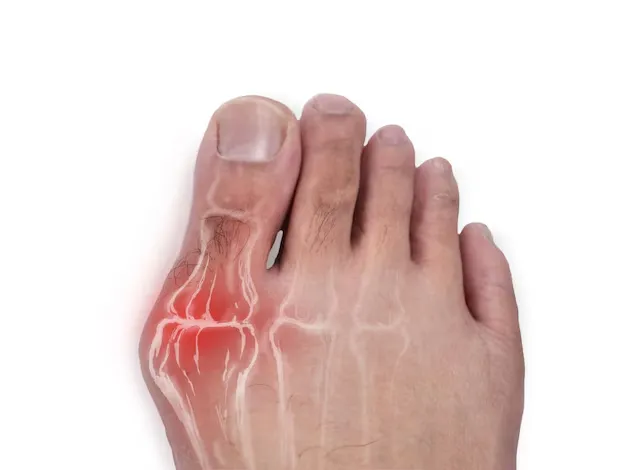
It’s not always easy to tell if that bump on your foot is a bunion or something else, like a cyst or arthritis-related swelling. However, there are specific signs that can help you figure it out.
Key Indicators That You Might Have a Bunion:
- Progressive appearance: The bump usually starts small and becomes more noticeable over time.
- Foot shape changes: Your big toe gradually drifts toward the second toe, altering the alignment of your entire forefoot.
- Pain in specific situations: Discomfort typically worsens when wearing tight shoes or after standing for long periods.
- Stiffness: The joint at the base of your big toe may feel less flexible, making it harder to move your toe freely.
- Recurring irritation: Frequent redness, swelling, or tenderness at the site of the bump, especially if it rubs against shoes.
If you recognize these signs, it’s a good idea to consult a podiatrist.
Early diagnosis can help you avoid more severe complications and the need for surgical intervention.
Common Symptoms of a Bunion
Not all bunions cause pain, especially in the early stages. But as the condition progresses, several symptoms typically appear.
Most Common Bunion Symptoms:
- Persistent pain: This can range from a dull ache to sharp discomfort, especially when walking or standing for long periods.
- Swelling and inflammation: The area around the bunion often becomes puffy and warm to the touch.
- Limited mobility: As the joint becomes more misaligned, it may be difficult to bend the big toe.
- Skin changes: Calluses or corns frequently develop due to increased friction between the toes or against footwear.
- Shoe fitting problems: Finding comfortable shoes becomes challenging as the bunion grows and alters your foot’s shape.
These symptoms can interfere with your daily activities, making it uncomfortable to exercise, walk, or even stand for extended periods.
When to See a Podiatrist
You don’t need to wait until the pain becomes unbearable to seek professional help. In fact, early intervention can significantly improve outcomes and may prevent the need for surgery.
Consider Seeing a Podiatrist If You Notice:
- Ongoing pain or swelling that doesn’t improve with rest or over-the-counter treatments
- Difficulty finding shoes that fit comfortably
- Reduced mobility in your big toe
- Rapid progression in the size or severity of the bunion
At Foot, Ankle & Leg Vein Center, we offer personalized assessments and treatment plans ranging from conservative approaches, like orthotics and footwear changes, to surgical options when necessary.
Best Treatment Options for Bunions

There’s no one-size-fits-all approach to treating bunions.
The best treatment depends on how severe the bunion is, how much pain it causes, and how it affects your daily life.
Non-Surgical Treatment Options
Managing bunions without surgery is often possible, especially in mild to moderate cases. The goal is to relieve pressure on the joint, improve alignment, and reduce pain — all without invasive procedures.
- Footwear changes: Wearing shoes with a wide toe box, low heel, and proper arch support can dramatically reduce irritation and pressure around the bunion.
- Padding and taping: Bunion pads help cushion the area and reduce friction, while taping can offer temporary realignment and support for the toe joint.
- Medication: Over-the-counter anti-inflammatories like ibuprofen can ease discomfort and reduce swelling during flare-ups.
- Physical therapy: Targeted exercises strengthen the muscles around the joint and improve mobility, which may help slow the bunion’s progression.
- Custom orthotics: One of the most effective long-term strategies for bunion relief. These specially designed shoe inserts redistribute weight across the foot, helping to take pressure off the bunion and support proper foot mechanics.
At Foot, Ankle & Leg Vein Center, our doctors provide orthotics that are professionally measured, custom-fitted, and dispensed right in our office, ensuring the fit is tailored to your unique foot structure and gait.
Unlike generic insoles, these orthotics offer precise support that enhances comfort, improves alignment, and can help delay or even prevent the need for surgery.
Non-surgical approaches are most effective when guided by a podiatrist and used consistently alongside daily habit changes, like better footwear choices and activity modifications.
When Surgery Becomes the Best Option
For more severe or painful bunions, surgical correction may be the most effective route. Today, patients have access to advanced techniques that offer better outcomes with shorter recovery times.
Two widely used surgical methods include:
- MIS (Minimally Invasive Surgery): This technique uses small incisions to correct the bunion with less soft tissue disruption, leading to faster healing, less postoperative pain, and minimal scarring.
- Lapiplasty® 3D Bunion Correction: Unlike traditional surgeries that only address the visible bump, Lapiplasty corrects the root cause of the bunion in three dimensions, stabilizing the joint and significantly reducing the risk of recurrence.
Our doctors at Foot, Ankle & Leg Vein Center are trained in both traditional and innovative surgical approaches and can help determine which method is best based on your foot structure, lifestyle, and treatment goals.
Tips for Managing Bunion Pain at Home
While professional treatment is essential for long-term management, there are several practical steps you can take at home to relieve bunion discomfort:
- Apply ice: Reduces swelling and numbs the area after periods of activity.
- Use bunion cushions: Soft pads protect the bunion from shoe friction.
- Rest your feet: Avoid prolonged standing or walking to minimize stress on the joint.
- Elevate your foot: Helps decrease inflammation after a long day.
- Stretch your toes: Gentle toe stretches and foot exercises maintain mobility and strength.
These simple measures can make daily activities more comfortable and may help slow the progression of the deformity.
For some people, conservative treatments aren’t enough. If bunion pain persists despite non-surgical methods or if the deformity severely limits your mobility, surgery may be the best option.
Signs You Might Need Bunion Surgery:
- Chronic pain that interferes with walking or daily activities
- Significant deformity that worsens over time
- Difficulty wearing regular shoes
- Failed relief with conservative treatments
Bunionectomy, the surgical procedure to remove or realign the bunion, has evolved significantly in recent years.
Modern techniques are less invasive, with shorter recovery times and better long-term outcomes.
Investing in surgical correction through a qualified specialist ensures a personalized approach, tailored to your specific foot structure and lifestyle needs.
At Foot, Ankle & Leg Vein Center, we emphasize customized treatment plans to maximize both function and comfort post-surgery.
FAQs About Bunions
What does an early-stage bunion look like?
An early-stage bunion appears as a small, barely noticeable bump at the base of the big toe. The toe may start to drift slightly toward the second toe, but significant misalignment is not yet present.
Pain may be minimal or absent at this stage, though some people experience discomfort after wearing tight shoes. Early intervention at this point can prevent further progression.
Is it OK to ignore a bunion if it doesn’t hurt?
Ignoring a bunion, even if it’s painless, is not advisable. Bunions are a progressive condition, meaning they typically worsen over time.
Without addressing the underlying structural issue, the deformity can become more severe, leading to chronic pain, joint damage, and difficulty walking.
Early consultation with a podiatrist allows for conservative management strategies that can slow or halt progression.
What shoes are best for bunions?
The best shoes for bunions have wide toe boxes that accommodate the natural spread of your toes, minimizing pressure on the bunion.
Look for styles with soft, flexible uppers and good arch support to improve foot alignment and comfort.
Avoid high heels and narrow or pointed-toe shoes, as these exacerbate bunion development and increase discomfort.
Orthopedic brands often offer footwear specifically designed for bunion relief.
How painful is bunion surgery?
Bunion surgery, or bunionectomy, is typically well-tolerated with modern techniques and anesthesia.
While some postoperative discomfort is expected, most patients report manageable pain that improves within a few days to weeks.
Recovery time varies depending on the specific procedure performed, but following your surgeon’s postoperative care instructions can minimize pain and reduce complications.
Need Guidance on Managing Your Bunion?
If you’re noticing changes in your foot shape or dealing with persistent discomfort, it may be time to consult a specialist.
At Foot, Ankle & Leg Vein Center, we provide thoughtful, personalized care for bunions, focusing on solutions that fit your lifestyle and long-term health.
Whether you’re looking for conservative management or considering surgical options, our team is here to help you make informed decisions about your foot health.
Contact us to schedule a consultation and take the first step toward greater comfort and mobility.
